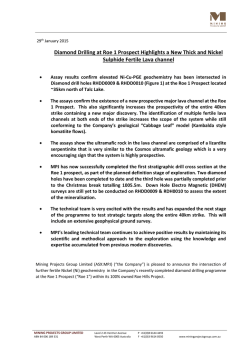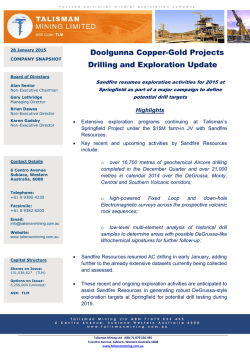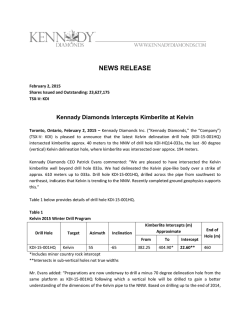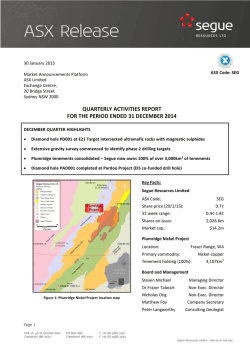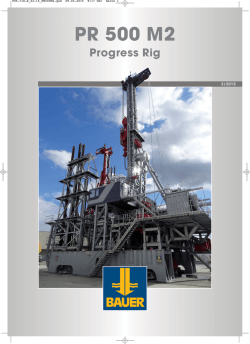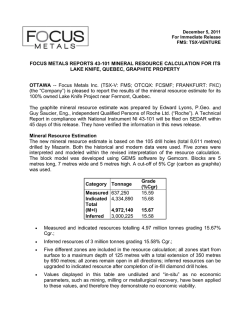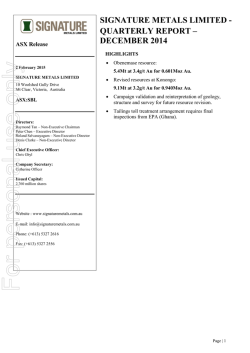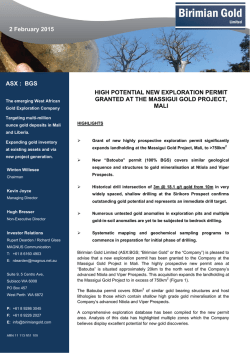
For personal use only - Australian Securities Exchange
SILVER CITY MINERALS LIMITED For personal use only Quarterly Report ASX Code: SCI HIGHLIGHTS Issued Shares: 116.3M Unlisted Options: 13.5M Cash Balance: $2.8 Figure 1. Silver City Minerals ABN: 68 130 933 309 DIRECTORS Bob Besley Chris Torrey Ian Plimer Greg Jones Ian Hume TOP SHAREHOLDERS (At 13 January 2015) Sentient Group: 17.74% Variscan Mines: 12.47% Fitel Nominees: 5.40% Top 20: 55.91% Head Office Level 1, 80 Chandos Street St Leonards NSW 2065 T: +61 (2) 9437 1737 F: +61 (2) 9906 5233 E: [email protected] www.silvercityminerals.com.au December 2014 HIGHLIGHTS Broken Hill, NSW (silver-lead-zinc) Three high priority targets were identified in a comprehensive study of Broken Hill tenements. Razorback West Corridor is a poorly exposed and explored belt of rock which is likely to be the northern, fault off-set, extension of the Broken Hill “line-of-lode”; the geological corridor which hosts the giant Broken Hill orebody. SCI has already identified a combined geophysical and geochemical anomaly which extends for 5 kilometres and is 1 kilometre wide. Geological studies suggest this zone holds potential for Broken Hill Type (BHT) mineralisation. Stephens Trig Corridor is the better exposed geological equivalent of Razorback West and hosts a number of BHT prospects and numerous old mine workings. Preliminary work by SCI at the Stephens Trig Prospect within the Corridor in 2012 returned an encouraging intersection of 1 metre of 7.4% zinc, 5.4% lead and 72 g/t silver (ASX Release 9 January 2012). Geological studies suggest a poorly exposed part of this belt holds potential for BHT mineralisation. Balaclava is a fault-bounded block which encloses the southern extension to the Broken Hill “line-of-lode”. SCI research of historic data indicates that a diamond drill hole from 1989 returned 10.1 metres of 6.8% zinc and 0.7% lead. The Company recently completed a rotary air blast (RAB) drilling program to sample bedrock beneath alluvial and soil cover. One hole intersected gossan for 9 metres from 2 metres downhole returning 0.48% % zinc, 0.61% lead and 0.27% copper. Untested electromagnetic conductors and strong geochemical anomalies within folded lode rock sequences make this area an attractive target for massive sulphide mineralisation. OUTLOOK A moving-loop electromagnetic survey designed to detect conductive sulphide bodies is due to commence at Razorback West early in February 2015. Detailed evaluations of historic work coupled with geological mapping and geochemical sampling at the Balaclava project and the new Stephens Trig Target Zone are ongoing. Field work on the New Zealand project is scheduled to commence early in February. 1 SILVER CITY MINERALS LIMITED For personal use only OPERATIONS New South Wales Projects Broken Hill Since floating the Company, exploration at Broken Hill has focussed on the discovery of near-surface deposits minable via open pit methods. The joint venture relationship with CBH Resources who own the Rasp mine at Broken Hill has provided an impetus for this approach. The Company has recently completed a comprehensive study of its tenement package at Broken Hill with the view to targeting larger, potentially deeper, deposits. The study has focussed on favourable rock sequences, areas of anomalous bedrock and soil geochemistry, mineral alteration assemblages (“lode rocks”) and responsive geophysics. In addition to this study SCI utilised a state-of-the-art electromagnetic survey (Versatile time domain electromagnetic; VTEM) to the west of Broken Hill. At Razorback West, an off-set pole-dipole induced polarisation (IP) survey was completed. Both are designed to look beneath regolith and bedrock cover for sulphide-enriched bodies at depth. The study has served to focus the Company on two geological trends to the north and northeast of Broken Hill; the Stephens Trig and Razorback West corridors, and the Balaclava prospect to the southwest of Broken Hill (Figure 1). Attempts to assess VTEM anomalies by RAB drilling at Acacia Vale, west of Broken Hill late in the Quarter were disrupted by inclement weather and mechanical delays. It is anticipated work will recommence early in 2015. Razorback West Corridor This corridor is considered to be the northern extension of the Broken Hill “line-of-lode”, offset by a fault known as the Stephens Creek Shear. It extends for 12 kilometres and is approximately 3 kilometres wide and is mostly buried beneath a veneer of alluvium and soil in a valley with little more than 10-15% outcropping rock (Figure 2). The Company has outlined a coincident lead-zinc geochemical, gravity and IP anomaly in the southern part of the corridor. This target zone is over 5 kilometres long and 1 kilometre wide. Despite its location with respect to the Broken Hill orebodies no historic drilling had been undertaken in the area. SCI initiated the first drilling in 2012 and to date has completed 18 holes. Drill holes have returned anomalous lead and zinc and have confirmed a favourable host-rock sequence (ASX Release 12 July 2012, Quarterly Report September 2013). The area of anomalous rock is large and in order to define massive sulphide drill targets within it, the Company will conduct ground electromagnetic (EM) surveys. Work scheduled to start in November has been delayed until February to order to conform to landowner access requirements. Stephens Trig Corridor This belt is very similar to that which occurs at Razorback West and geological interpretations suggest that they are both part of the same folded sequence. Whereas the Razorback West rocks are largely unexposed, many of the Stephens Trig rocks crop out; providing a better geological understanding of the area. A number of prospects have been identified by past explorers and there are clusters of old mine workings. The belt extends for over 15 kilometres from Trig South in the south to Rise and Shine and Peppertree in the north. It averages 1.5 kilometres wide. Historic records show that approximately 120 drill holes have tested a range of prospects along the entire length of the belt (compared to 18 at Razorback West). 2 SILVER CITY MINERALS LIMITED For personal use only The most significant drilling to date has been 31 holes located at Stephens Trig. This project does not crop out; much like Razorback West it lies beneath a veneer of alluvium and soil. Similarly it is broadly defined by a lead-zinc RAB geochemical anomaly which extends for 1.5 kilometres along strike with a further southern extension of over 2 kilometres over the Trig South prospect. The project was drilled by a number of explorers prior to SCI involvement. In 2004 during follow-up of an old reverse circulation percussion drill hole (drilled in 1991) containing an intersection of 6 metres at 11.8% zinc, 3.8% lead and 13 g/t silver, Sipa Resources Limited returned another encouraging intersection of 6 metres at 9.5% zinc, 0.7% lead and 14 g/t silver from 51 metres (Sipa ASX Release 7 April 2004). SCI drilled seven holes with the best intersection occurring in hole RCSCG012 with 1 metre of 7.4% zinc, 5.4% lead and 72 g/t silver (ASX Release 9 January 2012; Figure 3). SCI curtailed work of the project in 2012 to pursue Razorback West and other projects. The recent study has refocussed attention on the prospectivity of not only on the Stephens Trig project, but the entire Stephens Trig Corridor. In particular, geological interpretations suggest significant potential for silver-lead-zinc mineralisation 0.5 to 1.5 kilometres to the east of Stephens Trig and Trig South (“Stephens Trig Target Zone”; Figure 2). This is an area which lies beneath alluvial and soil cover. Geophysical interpretations suggest it is underlain by the prospective Broken Hill Group rocks. To date there has been some wide spaced (300 to 600 metre spaced lines) shallow RAB drilling undertaken in this area and preliminary ground EM surveys. A fence of ten, 200 metre deep RC holes tests a portion of the new target zone east of Trig South. Both the RAB and RC drilling confirm the presence of BHT alteration assemblages and a favourable rock package. SCI is currently reviewing historic exploration data for this area. Like the Razorback West target zone the Company is of the view that exploration to date has been inadequate to fully assess the mineral potential. Balaclava Like Razorback West in the north, Balaclava is thought to be located within the southern extension of the Broken Hill “lineof-lode” corridor. Geological targets have been identified in the current study and a program of preliminary RAB drilling was completed in October 2014. A total of 80 shallow holes were completed for a total of 1372 metres of drilling. This data augments shallow (less than 20 metre) auger drilling completed in 1975 by a previous explorer. The results combined with geological interpretation outline a sequence of tightly folded rocks hosting abundant alteration minerals as well as anomalous lead-zinc mineralisation. Lead-zinc geochemical anomalies extend in a generally northwest orientation in a series of narrow elongate zones. The largest extends for 2 kilometres and encompasses lode rocks, the prospective Potosi Gneiss and a number of old mine shafts (Figures 4). Historic drilling shows that mineralisation associated with a small surface geochemical anomaly occurs within hole 89BCLA007 returning 10.1 metres of 6.83% zinc and 0.69% lead from 193.3 metres. One RAB hole in this anomaly drilled by SCI encountered near-surface gossan to the end of the hole and returned an intersection of 9 metres at 0.48% zinc, 0.61% lead, 0.27% copper and 0.45 ppm silver from 2 metres. SCI has obtained data from historic University of Toronto electromagnetic (UTEM) surveys conducted in 1991. With the exception of hole 91BCL10 all drilling predates this geophysical survey. Two significant EM conductors were identified but were never drill tested (Figure 5). 3 SILVER CITY MINERALS LIMITED For personal use only The first, some 250 metres long, is located north of the collar of hole 89BCLA07 and is interpreted to be dipping at approximately 45 degrees to the northeast. This conductor confirms an earlier-identified moving loop Sirotem conductor and appears to be located within the nose of a fold structure. This is a classic ore position in the Broken Hill line of lode and requires follow-up drilling. The second conductor extends in a north-north westerly orientation, is oblique to the strike of mapped rocks, is 800 metre long, steeply dipping and has been measured consistently on three survey lines. The source of the conductor is in excess of 200 metre deep and the geology of this zone is poorly understood. This clearly provides another drill target for future exploration. New Zealand Projects Taupo This project is focussed on the discovery of high grade epithermal gold-silver deposits near Rotorua in New Zealand. Access and approvals to explore have been granted. Reconnaissance geological mapping, rock chip sampling and mineralogical studies are scheduled to commence in February 2015. CORPORATE Net operating expenditure for the Quarter was $509k. This included $408k on projects, $131k on administration, offset by $30k received in income. Cash on hand at the end of the Quarter was approximately $2.8 million. The Company’s 29,167,263 listed options exercisable at 25 cents each expired on 19 December 2014. During the Quarter the Company withdrew from the Sellheim Project in North Queensland when results failed to meet expectations. The Stephens Trig and Balaclava projects are part of a joint venture with CBH Resources Limited. At Balaclava CBH contribute 25% of exploration expenditures. Razorback West is 100% SCI (refer to 2014 Annual Report). 4 SILVER CITY MINERALS LIMITED For personal use only SILVER CITY MINERALS LIMITED Christopher Torrey Managing Director ABOUT Silver City Minerals Limited Silver City Minerals Limited (SCI) is a base and precious metal explorer focused on the Broken Hill District of western New South Wales, Australia. It takes its name from the famous Silver City of Broken Hill, home of the world’s largest accumulation of silver, lead and zinc; the Broken Hill Deposit. SCI was established in May 2008 and has been exploring the District where it controls Exploration Licences through 100% ownership and various joint venture agreements. It has a portfolio of highly prospective projects with drill-ready targets focused on high grade silver, gold and base-metals, and a pipeline of prospects moving toward the drill assessment stage. It has acquired two tenements to explore for high grade gold and silver in an epithermal system near Rotorua, New Zealand. Competent Person The information in this report that relates to Exploration Results is based on information compiled by Christopher Torrey (BSc, MSc, RPGeo.) who is a member of the Australian Institute of Geoscientists. Mr Torrey is the Managing Director, a shareholder and full-time employee of Silver City Minerals Limited. Mr Torrey has sufficient experience relevant to the styles of mineralisation and type of deposits under consideration and to the activity he is undertaking to qualify as a Competent Person as defined in the 2012 Edition of the “Australasian Code for Reporting of Exploration Results, Mineral Resources and Ore Reserves”. Christopher consents to the inclusion in the report of the matters based on this information in the form and context in which it appears. 5 SILVER CITY MINERALS LIMITED For personal use only ANNEXURE 1 Table 1 Drill hole specifications. Historic drilling Balaclava. Hole Number Easting (metres) Northing (metres) Elevation (metres) Azimuth (degrees) Declination at Collar (degrees) Total Year Depth drilled (metres) 46BCLA01 534,818 6,447,708 220 046 -40 70.4 1946 46BCLA02 535,135 6,447,958 220 133 -55 95.1 1946 46BCLA03 534,526 6,448,317 220 285 -30 57.6 1946 46BCLA04 534,447 6,448,309 220 105 -45 50.0 1946 49BCLA05 534,975 6,447,879 220 074 -55 526.7 1949 86BCLA06 534,741 6,447,661 220 072 -68 574.9 1986 89BCLA07 534,728 6,447,933 220 219 -60 345.5 1989 88BCLA08 534,828 6,447,710 220 045.5 -60 155.0 1988 90BCL09 534,424 6,447,888 220 045 -60 595.0 1990 92BCL10 535545 6447138 220 086 -60 537.0 1992 Table 2 Significant intercepts from historic drill holes Balaclava. Hole Number From (m) To (m) Interval (m) Lead (%) Zinc (%) Silver (ppm) 46BCLA01 45.1 58.2 13.1 0.60 2.31 22 46BCLA03 47.5 50.9 3.4 0.70 2.00 9 46BCLA04 34.4 39.0 4.6 0.05 0.26 2 86BCLA06 75.0 86.0 11.0 0.21 0.67 4 86BCLA06 88.0 90.0 2.0 0.13 0.25 1 86BCLA06 156.9 158.0 1.1 0.64 0.09 3 86BCLA06 163.4 184.0 20.6 0.05 0.30 3 86BCLA06 278.0 281.0 3.0 0.09 0.34 1 89BCLA07 193.3 203.4 10.1 0.69 6.83 7 89BCLA07 225.2 229.9 4.7 1.36 3.78 8 88BCLA08 83.2 86.7 3.5 0.27 6.22 11 88BCLA08 90.9 94.9 3.8 0.06 2.94 5 88BCLA08 121.9 123.0 1.1 0.12 2.90 3 90BCL09 387.5 399.3 11.8 0.25 1.83 3 6 SILVER CITY MINERALS LIMITED For personal use only ANNEXURE 2 Diagrams Figure 1. Silver City Tenements and areas of focussed exploration. 7 For personal use only SILVER CITY MINERALS LIMITED Figure 2. North Broken Hill target zones. Diagram shows outcropping rock types and areas of alluvial and soil cover (pale yellow). The prospective Stephens Trig and Razorback West corridors trend in a northeast direction and lie to the north of the Stephens Creek Shear Zone. The Broken Hill orebodies are located to the south of the shear zone within the Broken Hill Mining Leases. The Target Zones outlined in red are areas of focussed exploration by SCI. 8 For personal use only SILVER CITY MINERALS LIMITED Figure 3. Stephens Trig drilling (SCI Quarterly Report December 2011). 9 For personal use only SILVER CITY MINERALS LIMITED Figure 4. Balaclava Project showing geology and historic drill hole intersections (above) and geophysics and geochemistry (below). 10 ANNEXURE 3 JORC Code, 2012 Edition – Table 1 For personal use only Section 1 Sampling Techniques and Data Criteria JORC Code explanation Commentary Sampling techniques Nature and quality of sampling (eg cut channels, random chips, or specific specialised industry standard measurement tools appropriate to the minerals under investigation, such as down hole gamma sondes, or handheld XRF instruments, etc). These examples should not be taken as limiting the broad meaning of sampling. Include reference to measures taken to ensure sample representivity and the appropriate calibration of any measurement tools or systems used. Aspects of the determination of mineralisation that are Material to the Public Report. In cases where ‘industry standard’ work has been done this would be relatively simple (eg ‘reverse circulation drilling was used to obtain 1 m samples from which 3 kg was pulverised to produce a 30 g charge for fire assay’). In other cases more explanation may be required, such as where there is coarse gold that has inherent sampling problems. Unusual commodities or mineralisation types (eg submarine nodules) may warrant disclosure of detailed information. Drill type (eg core, reverse circulation, open-hole hammer, rotary air blast, auger, Bangka, sonic, etc) and details (eg core diameter, triple or standard tube, depth of diamond tails, face-sampling bit or other type, whether core is oriented and if so, by what method, etc). Rotary air blast (RAB) holes were drilled at the Balaclava Prospect. 1 metre intervals were collected from the cyclone in either buckets or plastic bags by the drilling contractor. Samples were taken using a PVC spear. The bottom one metre interval of each hole was sampled. Samples were taken of other intervals between one and four metres wide were there was significant iron content, gossan or other material considered potentially anomalous in the interval. RAB is an “open-hole” drilling technique and was used here primarily to obtain rock for geological observation and geochemical analyses. XRF measurement tools were used as a first pass to help determine which intervals to sample. XRF results are not reported. Method of recording and assessing core and chip sample recoveries and results assessed. Measures taken to maximise sample recovery and ensure representative nature of the samples. Whether a relationship exists between sample recovery and grade and whether sample bias may have occurred due to preferential loss/gain of fine/coarse material. Whether core and chip samples have been geologically and geotechnically logged to a level of detail to support appropriate Mineral Resource estimation, mining studies and metallurgical studies. Whether logging is qualitative or quantitative in nature. Core (or costean, channel, etc) photography. The total length and percentage of the relevant intersections logged. No account of recovery was made. No measures were undertaken to maximize recovery. No relationship between grade and recovery was recorded or noted. If core, whether cut or sawn and whether quarter, half or all core taken. If non-core, whether riffled, tube sampled, rotary split, etc and whether 11 The subsample was collected in a bucket or bag for each metre. The geologist determined by observation which intervals Drilling techniques Drill sample recovery Logging Sub-sampling techniques and Rotary air blast (RAB) drilling used an industry standard facesampling hammer bit 75mm in diameter. No down-hole surveys were taken due to the shallow nature of the drilling. All holes were collared vertical. Representative RAB chips were geologically logged for each metre drilled to industry standard. Logging is qualitative and not of sufficient detail to support future Mineral Resource estimation, mining and metallurgical studies. 100% of drilled material was logged for a total of 1,372 metres. For personal use only Criteria JORC Code explanation Commentary sample preparation sampled wet or dry. For all sample types, the nature, quality and appropriateness of the sample preparation technique. Quality control procedures adopted for all sub-sampling stages to maximise representivity of samples. Measures taken to ensure that the sampling is representative of the in situ material collected, including for instance results for field duplicate/second-half sampling. Whether sample sizes are appropriate to the grain size of the material being sampled. The nature, quality and appropriateness of the assaying and laboratory procedures used and whether the technique is considered partial or total. For geophysical tools, spectrometers, handheld XRF instruments, etc, the parameters used in determining the analysis including instrument make and model, reading times, calibrations factors applied and their derivation, etc. Nature of quality control procedures adopted (eg standards, blanks, duplicates, external laboratory checks) and whether acceptable levels of accuracy (ie lack of bias) and precision have been established. to sample. Nominal sample weight was between 2kg and 2.5kg. A small sample of each 1 metre interval was collected in industry-standard chip trays for shallow holes, and for the bottom five metres for deeper holes for future reference The above techniques are considered appropriate for the nature of mineralisation anticipated and the first-pass nature of the drilling program. The sample size is appropriate to the rock being sampled. The logs note whether the sample was dry or damp. Quality of assay data and laboratory tests Verification of sampling and assaying Location of data points Data spacing and distribution The verification of significant intersections by either independent or alternative company personnel. The use of twinned holes. Documentation of primary data, data entry procedures, data verification, data storage (physical and electronic) protocols. Discuss any adjustment to assay data. Accuracy and quality of surveys used to locate drill holes (collar and down-hole surveys), trenches, mine workings and other locations used in Mineral Resource estimation. Specification of the grid system used. Quality and adequacy of topographic control. Data spacing for reporting of Exploration Results. Whether the data spacing and distribution is sufficient to establish the degree of geological and grade continuity appropriate for the Mineral Resource and Ore Reserve estimation procedure(s) and classifications applied. Whether sample compositing has been applied. 12 Preparation was by ALS method PUL-23 whereby the sample was crushed to 70% nominal 6mm, then was riffle-split to a maximum of 3kg then pulverized to 85% passing 75 microns Multi-element analysis by ALS method ME-ICP41 (www.alsglobal.com) for 35 elements. The nature and quality of the analytical methods are appropriate to style of mineralisation anticipated and are of industry standard. No handheld analytical tools used. The laboratory also has its own QAQC of systematic standard, repeats and duplicates. No standards or blanks were used. No external laboratory checks are appropriate at this early stage of assessment. Verification of intersections has been undertaken by alternative company personnel. Twinning is not appropriate at this time All logged data including sample intervals and numbers were recorded manually then entered into a digital data system. No adjustments have been made. Drill collar locations (GDA94 MGA Zone 54) were determined by handheld GPS with an accuracy of +/- 5 metres which is considered an appropriate level of accuracy for regional, early stage target assessments. Topographic control used is Shuttle Radar Topography Mission (SRTM) data. Individual points are verified by hand held GPS. This is considered sufficient for an early drill assessment. Sufficient numbers of samples have been collected from the drill holes to give a representative geochemical response for the regolith and bedrock at that location and serve the purpose of initial investigation. The type of sample and spacing is not sufficient for future Mineral Resource and Ore Reserve estimation. For personal use only Criteria JORC Code explanation Commentary Orientation of data in relation to geological structure Drill hole orientation has been optimized geochemical anomalism in the regolith. No orientation-bias has been identified. Sample security Whether the orientation of sampling achieves unbiased sampling of possible structures and the extent to which this is known, considering the deposit type. If the relationship between the drilling orientation and the orientation of key mineralised structures is considered to have introduced a sampling bias, this should be assessed and reported if material. The measures taken to ensure sample security. Audits or reviews The results of any audits or reviews of sampling techniques and data. to test for Bagged samples were transported to a Broken Hill freight depot by company personnel. Samples were dispatched directly from the depot to the laboratory. No audits or reviews have been undertaken. Section 2 Reporting of Exploration Results (Criteria listed in the preceding section also apply to this section.) Criteria JORC Code explanation Commentary Mineral tenement and land tenure status Type, reference name/number, location and ownership including agreements or material issues with third parties such as joint ventures, partnerships, overriding royalties, native title interests, historical sites, wilderness or national park and environmental settings. The security of the tenure held at the time of reporting along with any known impediments to obtaining a licence to operate in the area. Acknowledgment and appraisal of exploration by other parties. All drilling has been undertaken within EL8076 under joint venture agreement with CBH Resources Limited. Areas being drilled are not subject the Native Title. An access agreement with the current landowner is in place. No impediments to operate are known. Exploration done by other parties 13 Exploration work at the Balaclava Prospect has been undertaken previously by numerous companies and has included extensive geophysical surveys and deep drilling. Our assessment suggests good quality geological mapping has been undertaken in an area of poor outcrop. Drilling, logging, sampling and assaying of drill core was undertaken to the quality acceptable to the industry at the time and is of sufficient quality to make geological interpretations. Drilling ranges in age from 1946 to 1992. Collar survey data is of variable quality and only two collars have been found and surveyed by handheld GPS. Downhole survey data is similarly variable with some data extracted from old plans and drill sections with younger holes having tabulated data. Assay data has been extracted from analytical assay sheets, plans, sections and old logs. Drill hole data for the Balaclava Prospect is included in Annexure 1 of this report. We are unable to comment on the quality of geophysical surveys but these appear to have been undertaken to industry standard using the best technology of the time. SCI considers that several geochemical and geophysical anomalies remain untested by drilling. For personal use only Criteria JORC Code explanation Commentary Geology Deposit type, geological setting and style of mineralisation. Broken Hill type Pb-Zn-Ag mineralisation Drill hole Information A summary of all information material to the understanding of the exploration results including a tabulation of the following information for all Material drill holes: o easting and northing of the drill hole collar o elevation or RL (Reduced Level – elevation above sea level in metres) of the drill hole collar o dip and azimuth of the hole o down hole length and interception depth o hole length. If the exclusion of this information is justified on the basis that the information is not Material and this exclusion does not detract from the understanding of the report, the Competent Person should clearly explain why this is the case. In reporting Exploration Results, weighting averaging techniques, maximum and/or minimum grade truncations (eg cutting of high grades) and cut-off grades are usually Material and should be stated. Where aggregate intercepts incorporate short lengths of high grade results and longer lengths of low grade results, the procedure used for such aggregation should be stated and some typical examples of such aggregations should be shown in detail. The assumptions used for any reporting of metal equivalent values should be clearly stated. These relationships are particularly important in the reporting of Exploration Results. If the geometry of the mineralisation with respect to the drill hole angle is known, its nature should be reported. If it is not known and only the down hole lengths are reported, there should be a clear statement to this effect (eg ‘down hole length, true width not known’). Appropriate maps and sections (with scales) and tabulations of intercepts should be included for any significant discovery being reported These should include, but not be limited to a plan view of drill hole collar locations and appropriate sectional views. Where comprehensive reporting of all Exploration Results is not practicable, representative reporting of both low and high grades and/or widths should be practiced to avoid misleading reporting of Exploration Results. Given the nature of RAB drilling is to obtain reconnaissance geological and geochemical data beneath a cover of regolith, a list of hole details is not justified. Hole locations and material geochemical results are shown in plan. Data aggregation methods Relationship between mineralisation widths and intercept lengths Diagrams Balanced reporting Other substantive exploration data Other exploration data, if meaningful and material, should be reported including (but not limited to): geological observations; geophysical 14 Industry standard weight-averaging techniques have been used to present data in this report. No upper cut has been incorporated. No nominal cutoff grades have been used. No short lengths of high grade have been aggregated No metal equivalent has been reported. The relationship between mineralisation intercepts and intercept lengths is unknown. Only downhole lengths are reported, true widths are unknown. See Annexure 2 Given there are only an average of 3 to 4 samples taken per hole, for the purposes of reporting downhole RAB geochemistry on attached plans we depict the maximum value of lead plus zinc in ppm. For historic auger data we use the only result available to us which is a bottom-of-hole sample and similarly lead plus zinc. This serves to outline a geochemical and geological trend which is the purpose of the work. All available information of significance has been included in this or previous reports. For personal use only Criteria JORC Code explanation Commentary Further work survey results; geochemical survey results; bulk samples – size and method of treatment; metallurgical test results; bulk density, groundwater, geotechnical and rock characteristics; potential deleterious or contaminating substances. The nature and scale of planned further work (eg tests for lateral extensions or depth extensions or large-scale step-out drilling). Diagrams clearly highlighting the areas of possible extensions, including the main geological interpretations and future drilling areas, provided this information is not commercially sensitive. 15 Work is at an early stage with further assessment of this RAB program and historical results ongoing.
© Copyright 2025
